
Journal of Mathematical Cryptology
Scope & Guideline
Illuminating the Path to Secure Information through Mathematical Rigor
Introduction
Aims and Scopes
- Mathematical Foundations of Cryptography:
The journal emphasizes the development and analysis of mathematical theories that underpin cryptographic protocols, including number theory, algebra, and combinatorics. - Cryptanalysis Techniques:
A significant focus is placed on the cryptanalysis of existing cryptographic schemes, assessing their security through various mathematical methods and providing insights into potential vulnerabilities. - Post-Quantum Cryptography:
With the rise of quantum computing, the journal has a strong emphasis on research related to post-quantum cryptographic systems, addressing the need for secure algorithms against quantum attacks. - Algorithmic Approaches:
Research often includes algorithmic developments for cryptographic applications, such as efficient key exchange protocols, signature schemes, and encryption methods. - Applications of Advanced Mathematical Concepts:
The journal explores the application of advanced mathematical concepts, such as lattice theory, elliptic curves, and tropical geometry, in the design and analysis of cryptographic systems.
Trending and Emerging
- Post-Quantum Security:
There is a marked increase in research focusing on post-quantum cryptographic algorithms and protocols, addressing the imminent threats posed by quantum computing to existing cryptographic systems. - Advanced Cryptanalysis Methods:
Recent publications have showcased innovative cryptanalysis techniques, including the use of machine learning and advanced algebraic methods to evaluate the security of cryptographic primitives. - Integration of Algebraic Structures:
Emerging research often integrates complex algebraic structures, such as isogenies and lattices, into cryptographic protocols, reflecting a trend towards more mathematically sophisticated approaches. - Privacy-Preserving Protocols:
A growing interest in privacy-preserving cryptographic schemes, such as secure multi-party computation and homomorphic encryption, indicates a shift towards protecting user data in cryptographic applications. - Efficient Implementation Techniques:
There is an increasing focus on the efficiency of cryptographic implementations, with research dedicated to optimizing algorithms for practical deployment in various computational environments.
Declining or Waning
- Classical Cryptographic Protocols:
Research on traditional cryptographic protocols, such as RSA and ElGamal, has seen a decline as newer, more secure methods are developed, particularly in the context of post-quantum cryptography. - Low-Dimensional Cryptanalysis:
There has been less emphasis on cryptanalysis techniques that focus solely on low-dimensional or simple algebraic structures, as the field shifts towards more complex and robust systems. - Basic Boolean Function Analysis:
Although still relevant, the frequency of papers focused on basic properties of Boolean functions has decreased as researchers increasingly turn to more intricate applications involving these functions in cryptographic schemes.
Similar Journals
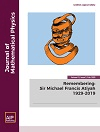
JOURNAL OF MATHEMATICAL PHYSICS
Fostering collaboration in the realm of mathematical inquiry.Welcome to the JOURNAL OF MATHEMATICAL PHYSICS, a distinguished publication dedicated to the burgeoning fields of mathematical physics and statistical and nonlinear physics, published by AIP Publishing. Established in 1960, the journal continually showcases cutting-edge research and theoretical advancements that drive the understanding of complex systems and mathematical formulations within physics. With an impressive Scopus ranking of #38 in Mathematical Physics and #39 in Statistical and Nonlinear Physics, the journal is recognized for its vital contributions to the academic community, achieving a solid Q2 quartile ranking in both categories for 2023. While not an open-access journal, it remains a critical resource for researchers, professionals, and graduate students seeking insights into rigorous mathematical methods and their applications in physical sciences. Engage with the finest research as we converge toward new frontiers from 1960 to 2024, fostering academic collaboration and innovation.

COLLOQUIUM MATHEMATICUM
Engaging minds with groundbreaking mathematical concepts.COLLOQUIUM MATHEMATICUM, published by ARS POLONA-RUCH, serves as an essential platform for the dissemination of innovative research in the field of mathematics. With an ISSN of 0010-1354 and a dedicated E-ISSN of 1730-6302, this journal plays a crucial role in advancing mathematical knowledge and fostering collaboration within the academic community. Although it is categorized in the Q3 quartile for miscellaneous mathematics, its content consistently attracts a diverse readership, reflecting a wide array of mathematical disciplines. Spanning publication years from 2001 to 2009 and resuming from 2011 to the present, *COLLOQUIUM MATHEMATICUM* offers researchers, professionals, and students the unique opportunity to engage with groundbreaking concepts and methodologies. With its home base in Warsaw, Poland, this journal not only contributes to the regional mathematical landscape but also impacts the broader global community. While currently not adopting an open access model, the journal remains committed to quality research, evidenced by its Scopus ranking within the general mathematics category. Engage with *COLLOQUIUM MATHEMATICUM* to be at the forefront of mathematical exploration.
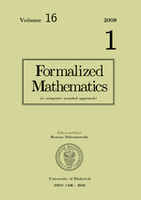
Formalized Mathematics
Connecting Mathematicians and Computer Scientists GloballyFormalized Mathematics is a pioneering open-access journal published by SCIENDO, dedicated to the field of formalized systems and mathematical foundations. Since its inception in 2006, it has provided a platform for researchers to discuss and disseminate advancements in applied mathematics and computational mathematics, emphasizing formalization in mathematical reasoning. Although recent coverage in Scopus has been discontinued, the journal still serves as a valuable resource for academics looking to deepen their understanding of formalized approaches to mathematical problems. With its ISSN 1898-9934, the journal not only promotes unrestricted access to quality research but also facilitates collaboration among mathematicians and computer scientists. Given its rankings—20th percentile in Applied Mathematics and 18th percentile in Computational Mathematics—Formalized Mathematics is a vital conduit for innovative research, making it a significant asset for students, professionals, and scholars aiming to explore the intersection of mathematics and formal logic.
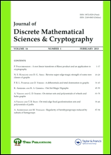
JOURNAL OF DISCRETE MATHEMATICAL SCIENCES & CRYPTOGRAPHY
Exploring the Frontiers of Mathematical SciencesThe Journal of Discrete Mathematical Sciences & Cryptography, published by Taru Publications, serves as a pivotal platform for researchers, professionals, and students in the fields of discrete mathematics and cryptography. Since its inception in 1998, the journal has consistently provided high-quality research articles, reviews, and case studies that span essential areas such as Algebra, Number Theory, and Applied Mathematics, achieving a Q3 category ranking in these disciplines as of 2023. With impressive Scopus rankings, including Rank #7 in Algebra and Number Theory and a notable 94th percentile status, this journal underscores its significance within the academic community. Although not an open access journal, it remains a crucial reference point for advancements in mathematical sciences, fostering scholarly dialogue and collaboration. As the field evolves, it continues to bridge theoretical frameworks and practical implementations, contributing substantially to the educational and professional landscape.

JOURNAL OF CRYPTOLOGY
Unlocking the Future of Security ResearchJOURNAL OF CRYPTOLOGY, published by SPRINGER, stands at the forefront of research in the domains of applied mathematics, computer science applications, and software security. With a history of significant contributions since its inception in 1988, this esteemed journal encompasses a broad range of topics in cryptology, including but not limited to encryption, security protocols, and information security systems. Holding a prestigious Q1 classification in multiple fields, it ranks #45 out of 635 in Applied Mathematics and has esteemed positions in Computer Science categories, reflecting its influence and recognition in the academic community, as evidenced by its high percentiles. As a vital resource for researchers, professionals, and students, the JOURNAL OF CRYPTOLOGY not only aims to disseminate innovative findings and methodologies but also fosters an engaging discourse within the cryptology and cybersecurity realms. Notably, it offers access through traditional subscription models, ensuring that readers benefit from a rigorous selection of high-impact research articles. Explore groundbreaking advancements and contribute to the ongoing dialogue in this pivotal field through your engagement with our journal.

Theoretical Computer Science
Exploring the Foundations of Algorithms and LogicTheoretical Computer Science, published by Elsevier, serves as a pivotal platform in the field of computational theory, exploring the foundational aspects of computer science and mathematical logic since its inception in 1975. With both a print ISSN of 0304-3975 and an E-ISSN of 1879-2294, this journal is esteemed for its rigorous peer-review process and commitment to advancing knowledge in theoretical frameworks and algorithms. Positioned in the Q2 quartile for both Computer Science (miscellaneous) and Theoretical Computer Science categories, it ranks #124 out of 232 in general computer science and #73 out of 130 in theoretical computer science according to Scopus metrics, reflecting its significant influence and reach within the academic community. Researchers and professionals can access this journal through institutional subscriptions, providing a plethora of high-quality articles that contribute to ongoing debates and developments in the discipline. The journal's scope encompasses a wide array of topics, ensuring relevance across various subfields, thus making it an essential resource for anyone dedicated to furthering their understanding of theoretical computer science.
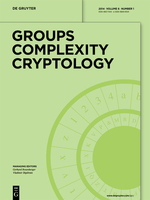
Groups Complexity Cryptology
Pioneering Open Access Research in Applied Mathematics and CryptologyGroups Complexity Cryptology, published by EPISCIENCES, is an esteemed Open Access journal that has been contributing to the fields of Applied Mathematics, Computational Mathematics, Computational Theory, and Computer Networks and Communications since its inception in 2009. With its headquarters located in France, this journal serves as a crucial platform for disseminating innovative research and solutions in cryptology and related areas. As of 2023, it proudly holds Q4 rankings across several categories in Scopus, indicating its recognized, yet emerging position within the academic community. Additionally, it is indexed under various categories such as Applied Mathematics, where it ranks in the 24th percentile, showcasing its potential for growth and increased visibility among researchers. The journal adheres to an open-access model introduced in 2020, allowing for widespread accessibility and engagement with cutting-edge research. This enhances the journal's mission to foster academic communication and collaboration among researchers, professionals, and students interested in the complex interplay of groups, complexity, and cryptography.

REPORTS ON MATHEMATICAL PHYSICS
Bridging Theories: Where Math Meets PhysicsREPORTS ON MATHEMATICAL PHYSICS is a distinguished journal published by PERGAMON-ELSEVIER SCIENCE LTD, focusing on the intricate interplay between mathematics and physics. Established in the United Kingdom, this journal has been contributing to the academic community since its inception, publishing significant research findings that explore the theoretical underpinnings of physical phenomena. With an ISSN of 0034-4877 and an E-ISSN of 1879-0674, the journal maintains a consistent publishing history, converging research from 1970 to 2024. It is currently ranked Q3 in both Mathematical Physics and Statistical and Nonlinear Physics categories, reflecting its commitment to maintaining a high standard of scholarly work. Although it lacks Open Access options, its targeted audience of researchers, professionals, and students will find invaluable insights into advanced mathematical methods, statistical applications, and innovative approaches in physics. With its esteemed reputation and critical role in the field, REPORTS ON MATHEMATICAL PHYSICS continues to be an essential resource for those seeking to deepen their understanding of mathematical applications in physical systems.

Rad Hrvatske Akademije Znanosti i Umjetnosti-Matematicke Znanosti
Empowering the Mathematical Community with ResearchRad Hrvatske Akademije Znanosti i Umjetnosti-Matematicke Znanosti is a distinguished journal published by the Croatian Academy of Sciences and Arts, focusing on the vast domain of mathematics and its multifaceted applications. Established in Croatia, this journal serves as a vital platform for scholars and practitioners to disseminate innovative and significant research findings in mathematical science. With an ISSN of 1849-2215, it has been indexed in Scopus, achieving a notable Q3 ranking in the miscellaneous category of mathematics, which reflects its influence and reach within the academic community. While currently not classified as an open-access journal, it endeavors to offer accessible insights and foster collaboration among researchers, professionals, and students. Published annually, it spans diverse topics critical to advancing mathematical understanding and promotes the exchange of ideas across international boundaries. Emphasizing quality, this journal contributes to the ongoing dialogue in the mathematical sciences, thereby strengthening academic ties and enhancing knowledge dissemination.
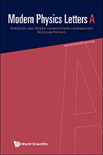
MODERN PHYSICS LETTERS A
Pioneering Discoveries in Modern PhysicsMODERN PHYSICS LETTERS A, published by World Scientific Publishing Co Pte Ltd, is a distinguished journal in the field of physics that serves as a pivotal platform for researchers, professionals, and students alike. With ISSN 0217-7323 and E-ISSN 1793-6632, the journal has gained international acclaim for its contributions to Astronomy and Astrophysics as well as Nuclear and High Energy Physics. The journal is ranked in Q3 for both Astronomy and Astrophysics and Nuclear and High Energy Physics, showcasing its relevance in these areas, while also achieving a Q2 ranking in the broader category of Physics and Astronomy (miscellaneous). Spanning from 1996 to 2024, MODERN PHYSICS LETTERS A promotes open dialogue and dissemination of pioneering research findings and innovative theories. While the journal operates without an open access option, its rich content is easily accessible through various academic databases, ensuring that vital research is shared widely among the scientific community. Situated in Singapore, this journal plays an essential role in the continuous advancement of the physics discipline, fostering collaboration and knowledge sharing among global researchers.